Comprehensive Analysis: Australian Hospitality Experience and Design
VerifiedAdded on 2020/07/23
|11
|3227
|45
Report
AI Summary
This report offers a comprehensive analysis of the Australian hospitality industry, focusing on the elements that shape guest experiences and drive competitive advantage. It begins by defining the concept of experience, highlighting its key components such as vision, physical environment, and human interaction. The report then differentiates hospitality experiences from other product and service experiences, emphasizing their unique characteristics like perishability and the importance of immediate customer interaction. It explores how hospitality experiences begin and end, detailing the steps involved in delivering exceptional service, including active listening, technological integration, and blended customer service. The report also examines the extent to which management influences experience through design, discussing practices like attentiveness, recognition, personalization, and appreciation. Ultimately, the report provides a detailed overview of how these factors contribute to customer satisfaction and the overall success of the Australian hospitality sector.
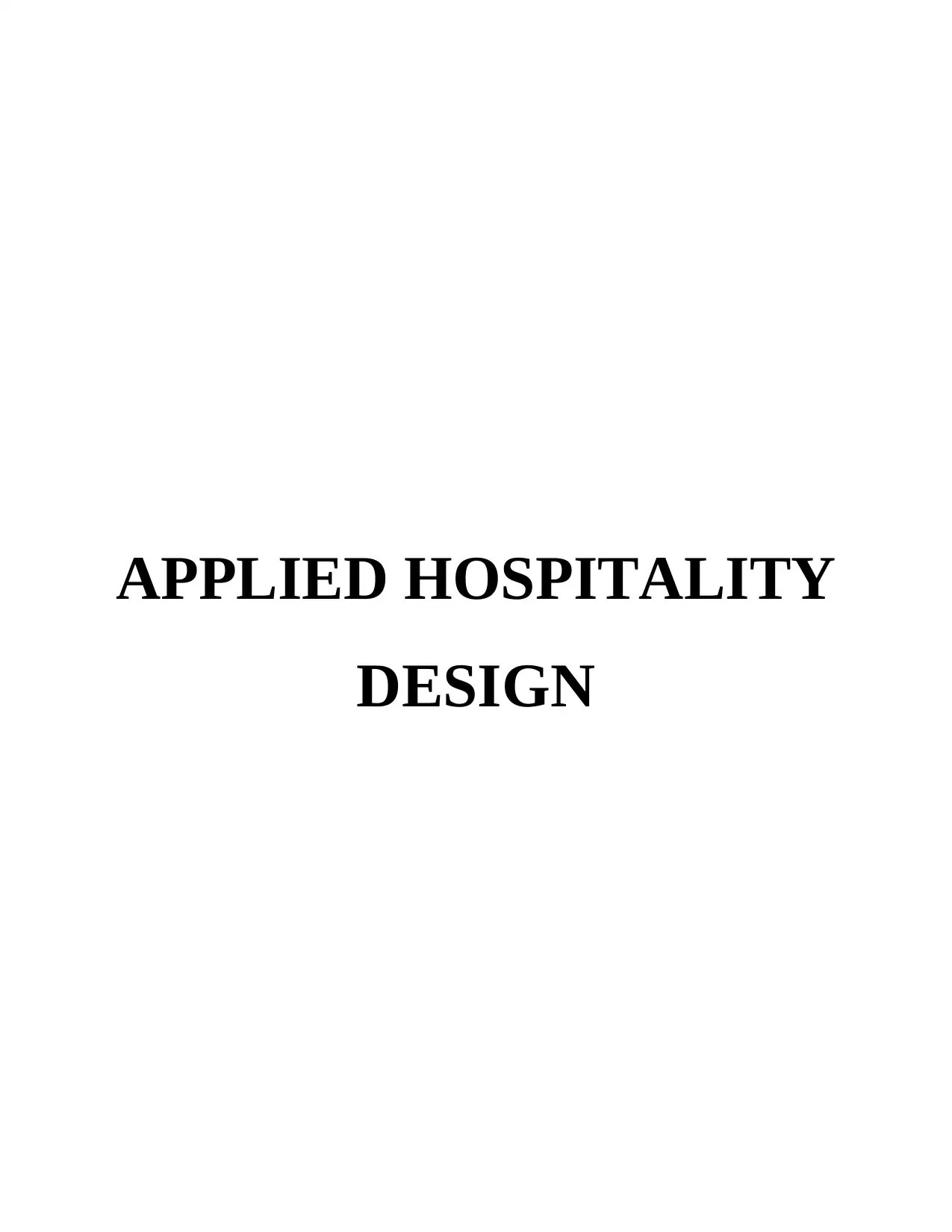
APPLIED HOSPITALITY
DESIGN
DESIGN
Paraphrase This Document
Need a fresh take? Get an instant paraphrase of this document with our AI Paraphraser
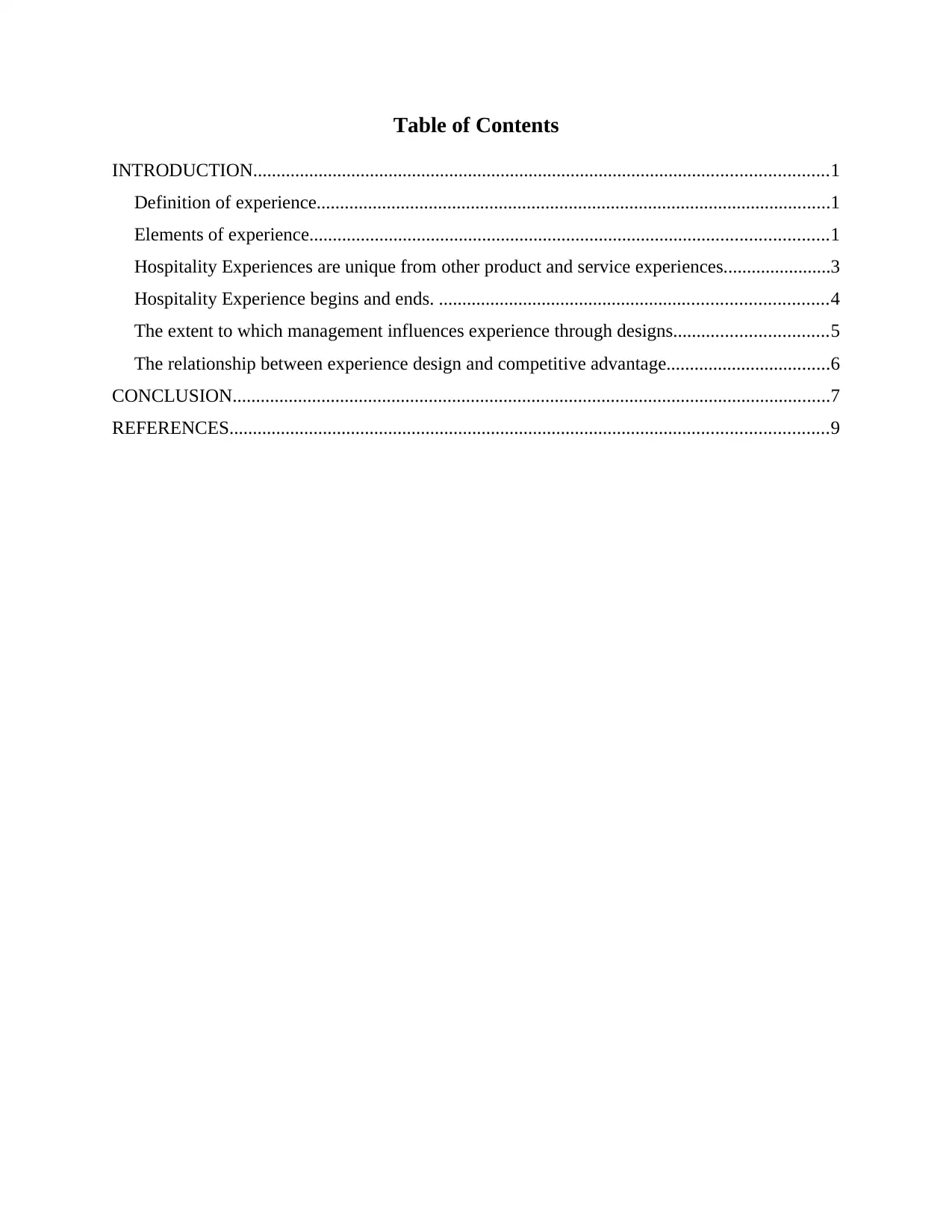
Table of Contents
INTRODUCTION...........................................................................................................................1
Definition of experience..............................................................................................................1
Elements of experience...............................................................................................................1
Hospitality Experiences are unique from other product and service experiences.......................3
Hospitality Experience begins and ends. ...................................................................................4
The extent to which management influences experience through designs.................................5
The relationship between experience design and competitive advantage...................................6
CONCLUSION................................................................................................................................7
REFERENCES................................................................................................................................9
INTRODUCTION...........................................................................................................................1
Definition of experience..............................................................................................................1
Elements of experience...............................................................................................................1
Hospitality Experiences are unique from other product and service experiences.......................3
Hospitality Experience begins and ends. ...................................................................................4
The extent to which management influences experience through designs.................................5
The relationship between experience design and competitive advantage...................................6
CONCLUSION................................................................................................................................7
REFERENCES................................................................................................................................9
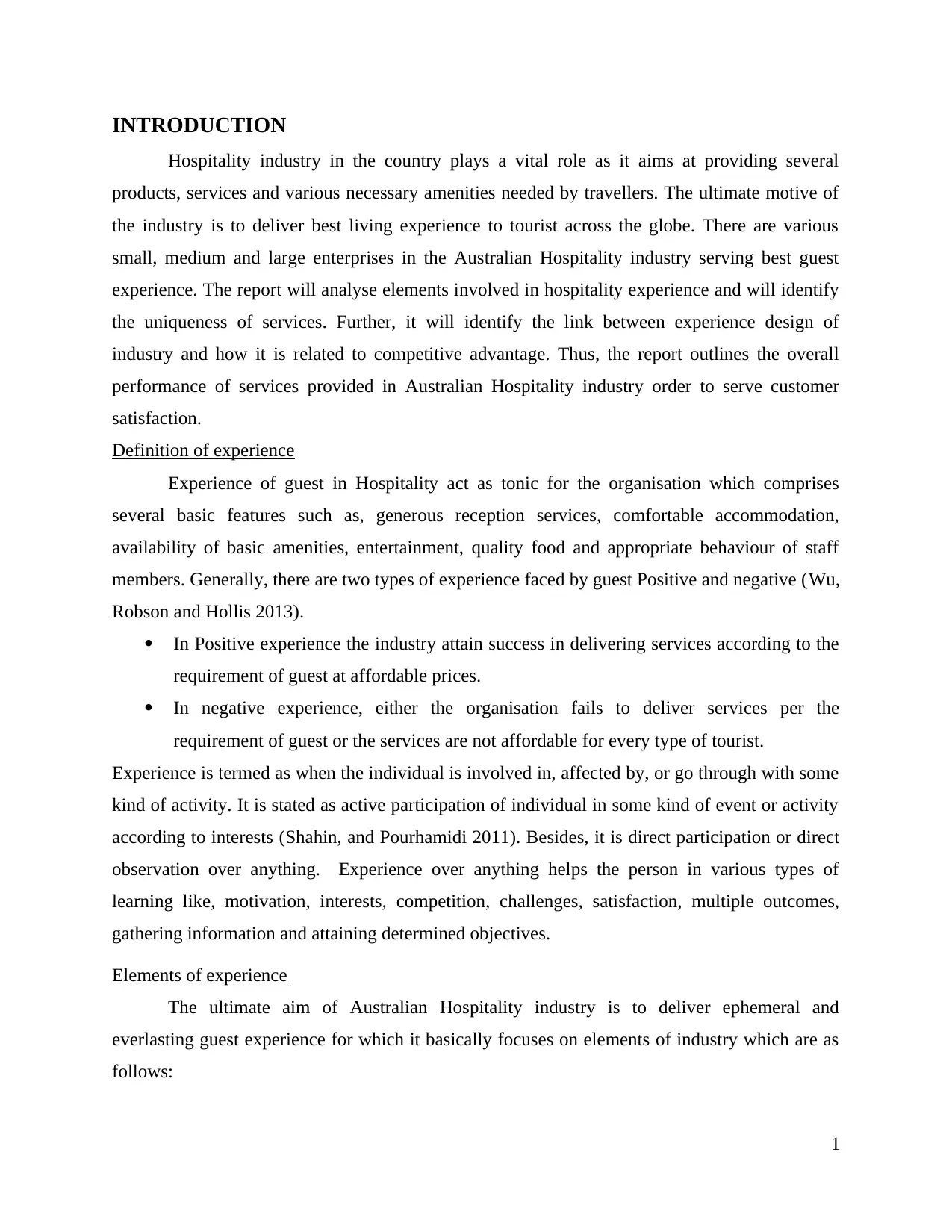
INTRODUCTION
Hospitality industry in the country plays a vital role as it aims at providing several
products, services and various necessary amenities needed by travellers. The ultimate motive of
the industry is to deliver best living experience to tourist across the globe. There are various
small, medium and large enterprises in the Australian Hospitality industry serving best guest
experience. The report will analyse elements involved in hospitality experience and will identify
the uniqueness of services. Further, it will identify the link between experience design of
industry and how it is related to competitive advantage. Thus, the report outlines the overall
performance of services provided in Australian Hospitality industry order to serve customer
satisfaction.
Definition of experience
Experience of guest in Hospitality act as tonic for the organisation which comprises
several basic features such as, generous reception services, comfortable accommodation,
availability of basic amenities, entertainment, quality food and appropriate behaviour of staff
members. Generally, there are two types of experience faced by guest Positive and negative (Wu,
Robson and Hollis 2013).
In Positive experience the industry attain success in delivering services according to the
requirement of guest at affordable prices.
In negative experience, either the organisation fails to deliver services per the
requirement of guest or the services are not affordable for every type of tourist.
Experience is termed as when the individual is involved in, affected by, or go through with some
kind of activity. It is stated as active participation of individual in some kind of event or activity
according to interests (Shahin, and Pourhamidi 2011). Besides, it is direct participation or direct
observation over anything. Experience over anything helps the person in various types of
learning like, motivation, interests, competition, challenges, satisfaction, multiple outcomes,
gathering information and attaining determined objectives.
Elements of experience
The ultimate aim of Australian Hospitality industry is to deliver ephemeral and
everlasting guest experience for which it basically focuses on elements of industry which are as
follows:
1
Hospitality industry in the country plays a vital role as it aims at providing several
products, services and various necessary amenities needed by travellers. The ultimate motive of
the industry is to deliver best living experience to tourist across the globe. There are various
small, medium and large enterprises in the Australian Hospitality industry serving best guest
experience. The report will analyse elements involved in hospitality experience and will identify
the uniqueness of services. Further, it will identify the link between experience design of
industry and how it is related to competitive advantage. Thus, the report outlines the overall
performance of services provided in Australian Hospitality industry order to serve customer
satisfaction.
Definition of experience
Experience of guest in Hospitality act as tonic for the organisation which comprises
several basic features such as, generous reception services, comfortable accommodation,
availability of basic amenities, entertainment, quality food and appropriate behaviour of staff
members. Generally, there are two types of experience faced by guest Positive and negative (Wu,
Robson and Hollis 2013).
In Positive experience the industry attain success in delivering services according to the
requirement of guest at affordable prices.
In negative experience, either the organisation fails to deliver services per the
requirement of guest or the services are not affordable for every type of tourist.
Experience is termed as when the individual is involved in, affected by, or go through with some
kind of activity. It is stated as active participation of individual in some kind of event or activity
according to interests (Shahin, and Pourhamidi 2011). Besides, it is direct participation or direct
observation over anything. Experience over anything helps the person in various types of
learning like, motivation, interests, competition, challenges, satisfaction, multiple outcomes,
gathering information and attaining determined objectives.
Elements of experience
The ultimate aim of Australian Hospitality industry is to deliver ephemeral and
everlasting guest experience for which it basically focuses on elements of industry which are as
follows:
1
⊘ This is a preview!⊘
Do you want full access?
Subscribe today to unlock all pages.

Trusted by 1+ million students worldwide
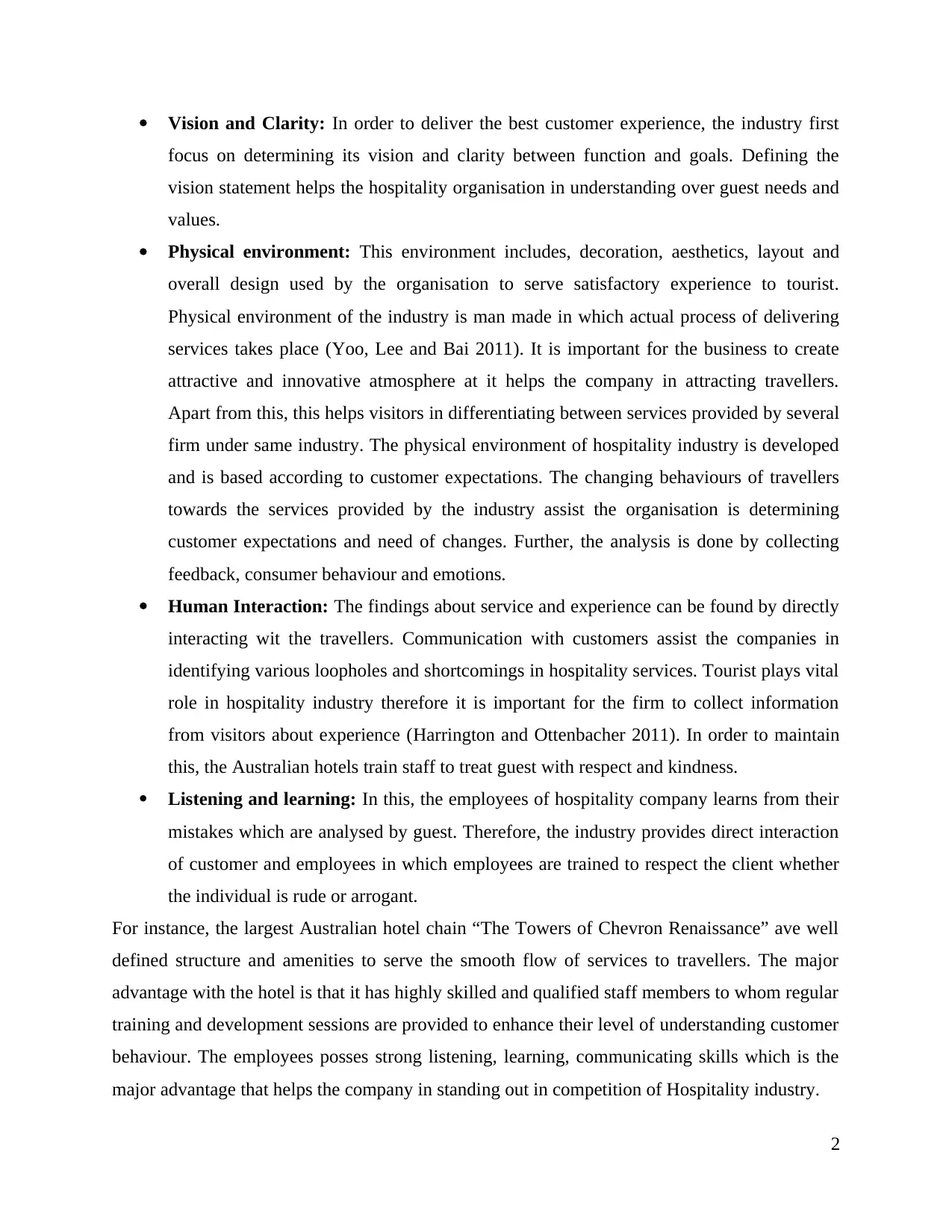
Vision and Clarity: In order to deliver the best customer experience, the industry first
focus on determining its vision and clarity between function and goals. Defining the
vision statement helps the hospitality organisation in understanding over guest needs and
values.
Physical environment: This environment includes, decoration, aesthetics, layout and
overall design used by the organisation to serve satisfactory experience to tourist.
Physical environment of the industry is man made in which actual process of delivering
services takes place (Yoo, Lee and Bai 2011). It is important for the business to create
attractive and innovative atmosphere at it helps the company in attracting travellers.
Apart from this, this helps visitors in differentiating between services provided by several
firm under same industry. The physical environment of hospitality industry is developed
and is based according to customer expectations. The changing behaviours of travellers
towards the services provided by the industry assist the organisation is determining
customer expectations and need of changes. Further, the analysis is done by collecting
feedback, consumer behaviour and emotions.
Human Interaction: The findings about service and experience can be found by directly
interacting wit the travellers. Communication with customers assist the companies in
identifying various loopholes and shortcomings in hospitality services. Tourist plays vital
role in hospitality industry therefore it is important for the firm to collect information
from visitors about experience (Harrington and Ottenbacher 2011). In order to maintain
this, the Australian hotels train staff to treat guest with respect and kindness.
Listening and learning: In this, the employees of hospitality company learns from their
mistakes which are analysed by guest. Therefore, the industry provides direct interaction
of customer and employees in which employees are trained to respect the client whether
the individual is rude or arrogant.
For instance, the largest Australian hotel chain “The Towers of Chevron Renaissance” ave well
defined structure and amenities to serve the smooth flow of services to travellers. The major
advantage with the hotel is that it has highly skilled and qualified staff members to whom regular
training and development sessions are provided to enhance their level of understanding customer
behaviour. The employees posses strong listening, learning, communicating skills which is the
major advantage that helps the company in standing out in competition of Hospitality industry.
2
focus on determining its vision and clarity between function and goals. Defining the
vision statement helps the hospitality organisation in understanding over guest needs and
values.
Physical environment: This environment includes, decoration, aesthetics, layout and
overall design used by the organisation to serve satisfactory experience to tourist.
Physical environment of the industry is man made in which actual process of delivering
services takes place (Yoo, Lee and Bai 2011). It is important for the business to create
attractive and innovative atmosphere at it helps the company in attracting travellers.
Apart from this, this helps visitors in differentiating between services provided by several
firm under same industry. The physical environment of hospitality industry is developed
and is based according to customer expectations. The changing behaviours of travellers
towards the services provided by the industry assist the organisation is determining
customer expectations and need of changes. Further, the analysis is done by collecting
feedback, consumer behaviour and emotions.
Human Interaction: The findings about service and experience can be found by directly
interacting wit the travellers. Communication with customers assist the companies in
identifying various loopholes and shortcomings in hospitality services. Tourist plays vital
role in hospitality industry therefore it is important for the firm to collect information
from visitors about experience (Harrington and Ottenbacher 2011). In order to maintain
this, the Australian hotels train staff to treat guest with respect and kindness.
Listening and learning: In this, the employees of hospitality company learns from their
mistakes which are analysed by guest. Therefore, the industry provides direct interaction
of customer and employees in which employees are trained to respect the client whether
the individual is rude or arrogant.
For instance, the largest Australian hotel chain “The Towers of Chevron Renaissance” ave well
defined structure and amenities to serve the smooth flow of services to travellers. The major
advantage with the hotel is that it has highly skilled and qualified staff members to whom regular
training and development sessions are provided to enhance their level of understanding customer
behaviour. The employees posses strong listening, learning, communicating skills which is the
major advantage that helps the company in standing out in competition of Hospitality industry.
2
Paraphrase This Document
Need a fresh take? Get an instant paraphrase of this document with our AI Paraphraser
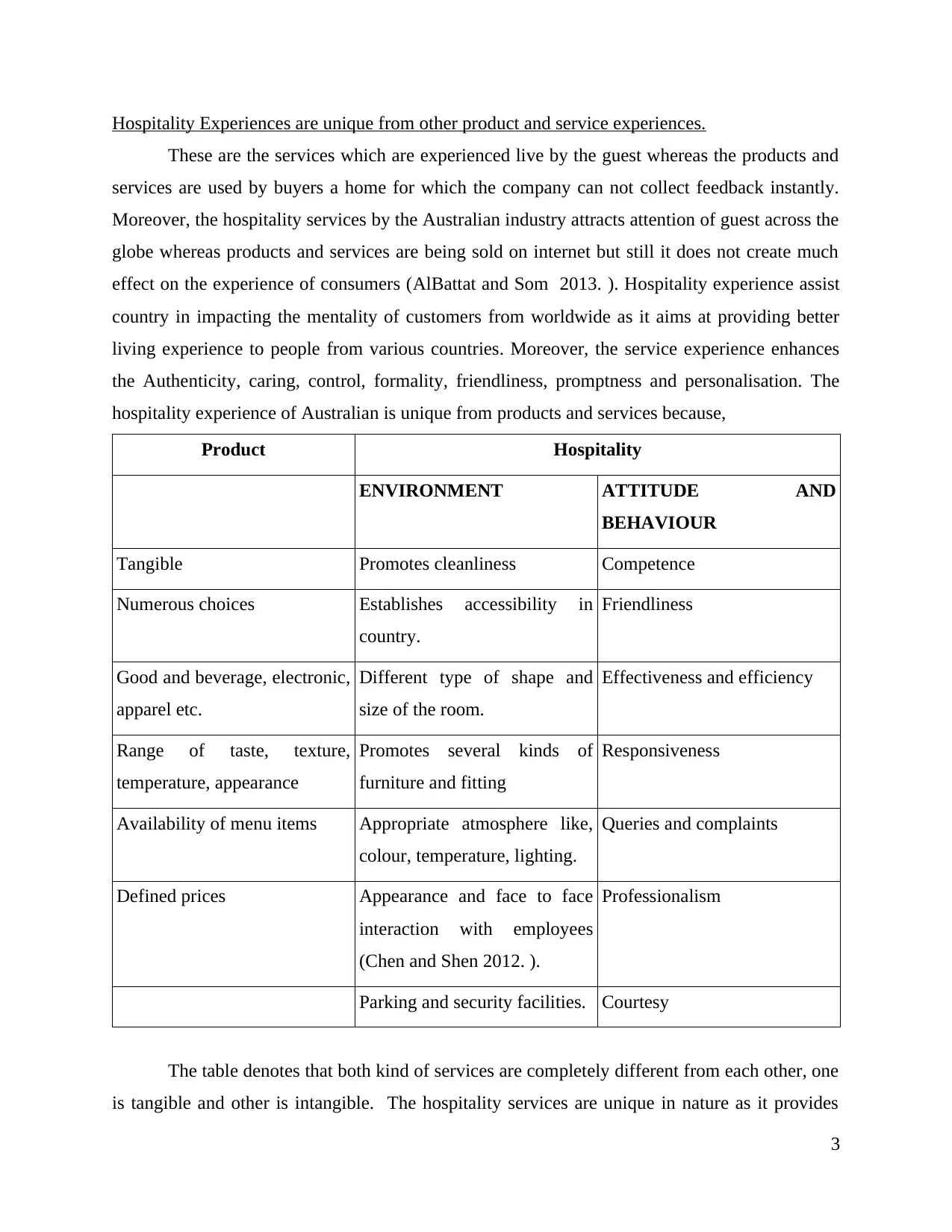
Hospitality Experiences are unique from other product and service experiences.
These are the services which are experienced live by the guest whereas the products and
services are used by buyers a home for which the company can not collect feedback instantly.
Moreover, the hospitality services by the Australian industry attracts attention of guest across the
globe whereas products and services are being sold on internet but still it does not create much
effect on the experience of consumers (AlBattat and Som 2013. ). Hospitality experience assist
country in impacting the mentality of customers from worldwide as it aims at providing better
living experience to people from various countries. Moreover, the service experience enhances
the Authenticity, caring, control, formality, friendliness, promptness and personalisation. The
hospitality experience of Australian is unique from products and services because,
Product Hospitality
ENVIRONMENT ATTITUDE AND
BEHAVIOUR
Tangible Promotes cleanliness Competence
Numerous choices Establishes accessibility in
country.
Friendliness
Good and beverage, electronic,
apparel etc.
Different type of shape and
size of the room.
Effectiveness and efficiency
Range of taste, texture,
temperature, appearance
Promotes several kinds of
furniture and fitting
Responsiveness
Availability of menu items Appropriate atmosphere like,
colour, temperature, lighting.
Queries and complaints
Defined prices Appearance and face to face
interaction with employees
(Chen and Shen 2012. ).
Professionalism
Parking and security facilities. Courtesy
The table denotes that both kind of services are completely different from each other, one
is tangible and other is intangible. The hospitality services are unique in nature as it provides
3
These are the services which are experienced live by the guest whereas the products and
services are used by buyers a home for which the company can not collect feedback instantly.
Moreover, the hospitality services by the Australian industry attracts attention of guest across the
globe whereas products and services are being sold on internet but still it does not create much
effect on the experience of consumers (AlBattat and Som 2013. ). Hospitality experience assist
country in impacting the mentality of customers from worldwide as it aims at providing better
living experience to people from various countries. Moreover, the service experience enhances
the Authenticity, caring, control, formality, friendliness, promptness and personalisation. The
hospitality experience of Australian is unique from products and services because,
Product Hospitality
ENVIRONMENT ATTITUDE AND
BEHAVIOUR
Tangible Promotes cleanliness Competence
Numerous choices Establishes accessibility in
country.
Friendliness
Good and beverage, electronic,
apparel etc.
Different type of shape and
size of the room.
Effectiveness and efficiency
Range of taste, texture,
temperature, appearance
Promotes several kinds of
furniture and fitting
Responsiveness
Availability of menu items Appropriate atmosphere like,
colour, temperature, lighting.
Queries and complaints
Defined prices Appearance and face to face
interaction with employees
(Chen and Shen 2012. ).
Professionalism
Parking and security facilities. Courtesy
The table denotes that both kind of services are completely different from each other, one
is tangible and other is intangible. The hospitality services are unique in nature as it provides
3
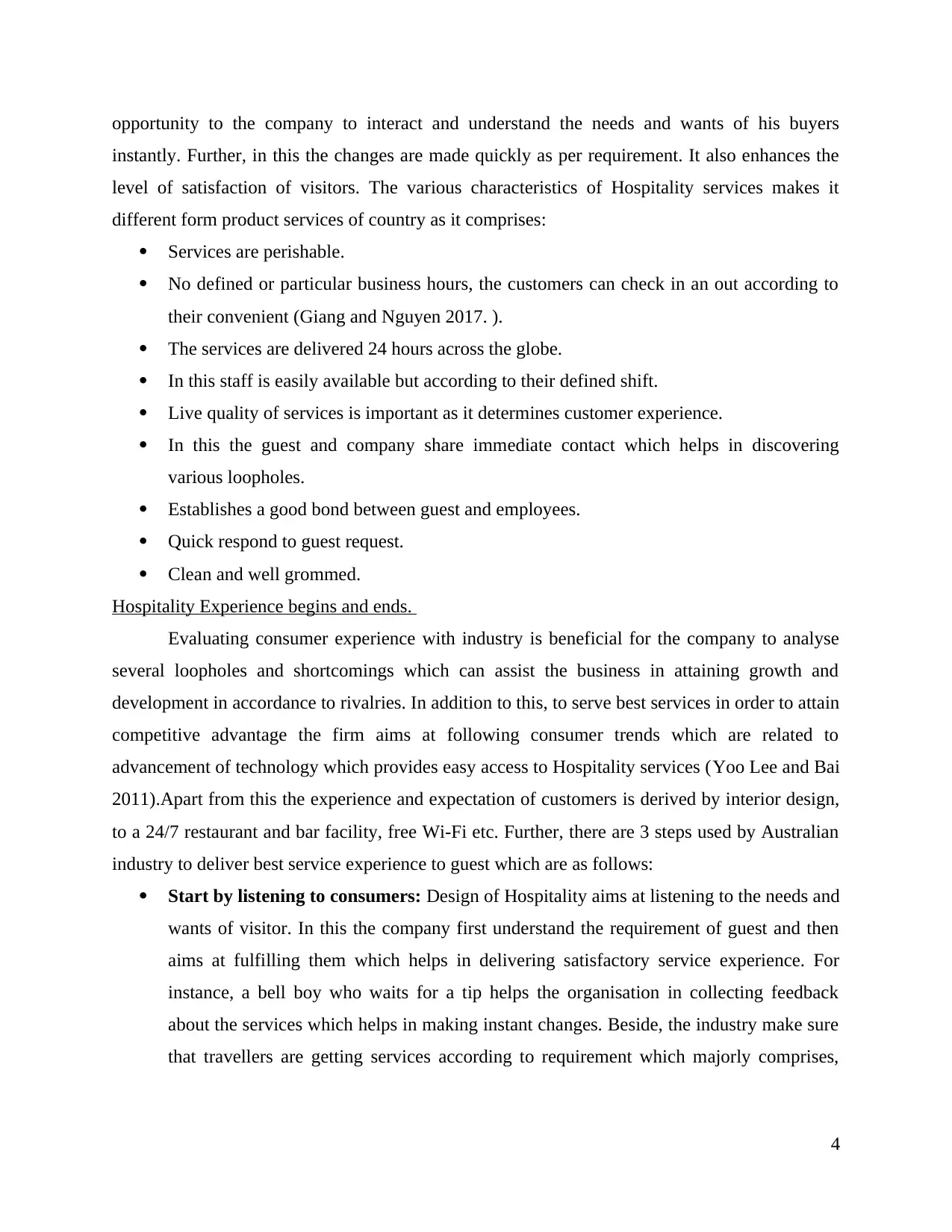
opportunity to the company to interact and understand the needs and wants of his buyers
instantly. Further, in this the changes are made quickly as per requirement. It also enhances the
level of satisfaction of visitors. The various characteristics of Hospitality services makes it
different form product services of country as it comprises:
Services are perishable.
No defined or particular business hours, the customers can check in an out according to
their convenient (Giang and Nguyen 2017. ).
The services are delivered 24 hours across the globe.
In this staff is easily available but according to their defined shift.
Live quality of services is important as it determines customer experience.
In this the guest and company share immediate contact which helps in discovering
various loopholes.
Establishes a good bond between guest and employees.
Quick respond to guest request.
Clean and well grommed.
Hospitality Experience begins and ends.
Evaluating consumer experience with industry is beneficial for the company to analyse
several loopholes and shortcomings which can assist the business in attaining growth and
development in accordance to rivalries. In addition to this, to serve best services in order to attain
competitive advantage the firm aims at following consumer trends which are related to
advancement of technology which provides easy access to Hospitality services (Yoo Lee and Bai
2011).Apart from this the experience and expectation of customers is derived by interior design,
to a 24/7 restaurant and bar facility, free Wi-Fi etc. Further, there are 3 steps used by Australian
industry to deliver best service experience to guest which are as follows:
Start by listening to consumers: Design of Hospitality aims at listening to the needs and
wants of visitor. In this the company first understand the requirement of guest and then
aims at fulfilling them which helps in delivering satisfactory service experience. For
instance, a bell boy who waits for a tip helps the organisation in collecting feedback
about the services which helps in making instant changes. Beside, the industry make sure
that travellers are getting services according to requirement which majorly comprises,
4
instantly. Further, in this the changes are made quickly as per requirement. It also enhances the
level of satisfaction of visitors. The various characteristics of Hospitality services makes it
different form product services of country as it comprises:
Services are perishable.
No defined or particular business hours, the customers can check in an out according to
their convenient (Giang and Nguyen 2017. ).
The services are delivered 24 hours across the globe.
In this staff is easily available but according to their defined shift.
Live quality of services is important as it determines customer experience.
In this the guest and company share immediate contact which helps in discovering
various loopholes.
Establishes a good bond between guest and employees.
Quick respond to guest request.
Clean and well grommed.
Hospitality Experience begins and ends.
Evaluating consumer experience with industry is beneficial for the company to analyse
several loopholes and shortcomings which can assist the business in attaining growth and
development in accordance to rivalries. In addition to this, to serve best services in order to attain
competitive advantage the firm aims at following consumer trends which are related to
advancement of technology which provides easy access to Hospitality services (Yoo Lee and Bai
2011).Apart from this the experience and expectation of customers is derived by interior design,
to a 24/7 restaurant and bar facility, free Wi-Fi etc. Further, there are 3 steps used by Australian
industry to deliver best service experience to guest which are as follows:
Start by listening to consumers: Design of Hospitality aims at listening to the needs and
wants of visitor. In this the company first understand the requirement of guest and then
aims at fulfilling them which helps in delivering satisfactory service experience. For
instance, a bell boy who waits for a tip helps the organisation in collecting feedback
about the services which helps in making instant changes. Beside, the industry make sure
that travellers are getting services according to requirement which majorly comprises,
4
⊘ This is a preview!⊘
Do you want full access?
Subscribe today to unlock all pages.

Trusted by 1+ million students worldwide
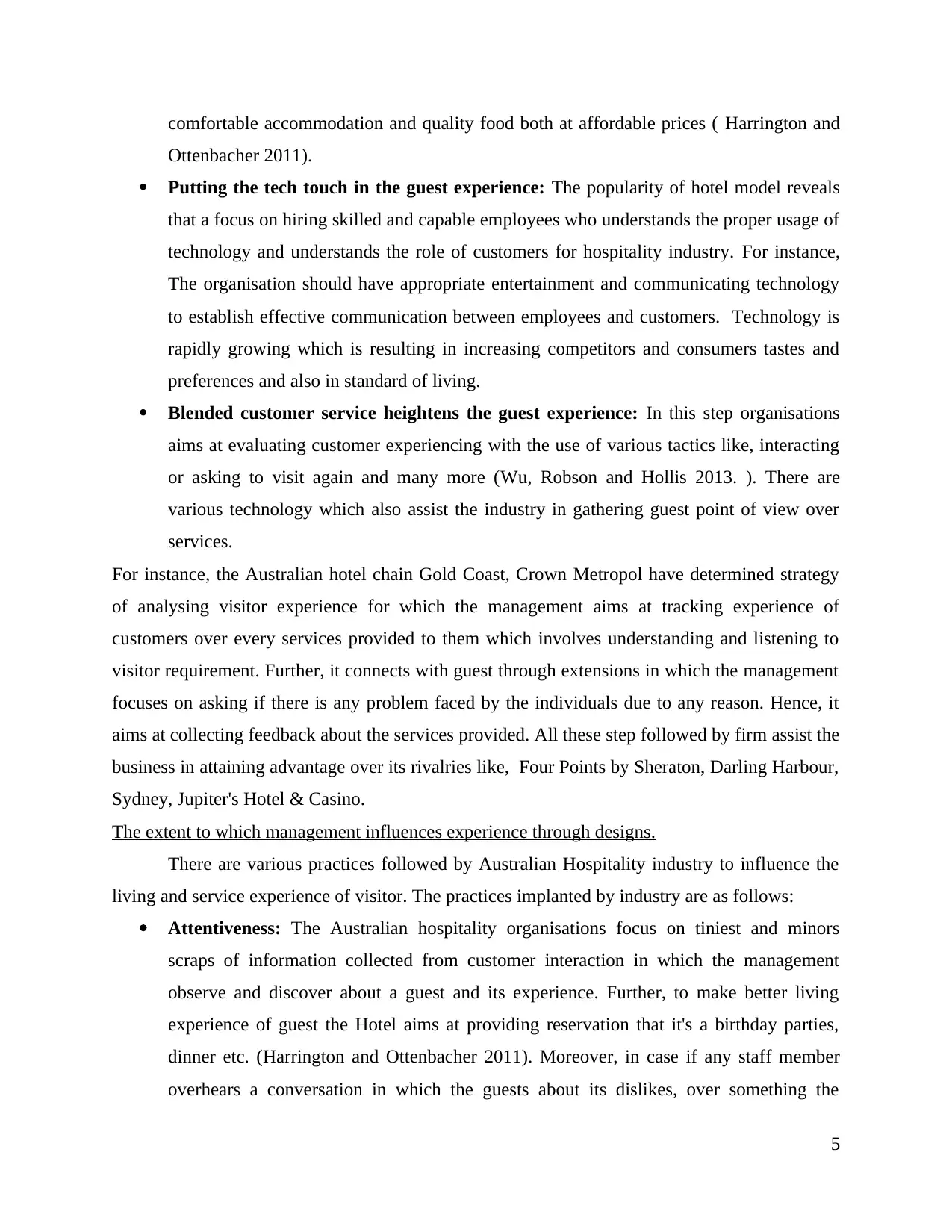
comfortable accommodation and quality food both at affordable prices ( Harrington and
Ottenbacher 2011).
Putting the tech touch in the guest experience: The popularity of hotel model reveals
that a focus on hiring skilled and capable employees who understands the proper usage of
technology and understands the role of customers for hospitality industry. For instance,
The organisation should have appropriate entertainment and communicating technology
to establish effective communication between employees and customers. Technology is
rapidly growing which is resulting in increasing competitors and consumers tastes and
preferences and also in standard of living.
Blended customer service heightens the guest experience: In this step organisations
aims at evaluating customer experiencing with the use of various tactics like, interacting
or asking to visit again and many more (Wu, Robson and Hollis 2013. ). There are
various technology which also assist the industry in gathering guest point of view over
services.
For instance, the Australian hotel chain Gold Coast, Crown Metropol have determined strategy
of analysing visitor experience for which the management aims at tracking experience of
customers over every services provided to them which involves understanding and listening to
visitor requirement. Further, it connects with guest through extensions in which the management
focuses on asking if there is any problem faced by the individuals due to any reason. Hence, it
aims at collecting feedback about the services provided. All these step followed by firm assist the
business in attaining advantage over its rivalries like, Four Points by Sheraton, Darling Harbour,
Sydney, Jupiter's Hotel & Casino.
The extent to which management influences experience through designs.
There are various practices followed by Australian Hospitality industry to influence the
living and service experience of visitor. The practices implanted by industry are as follows:
Attentiveness: The Australian hospitality organisations focus on tiniest and minors
scraps of information collected from customer interaction in which the management
observe and discover about a guest and its experience. Further, to make better living
experience of guest the Hotel aims at providing reservation that it's a birthday parties,
dinner etc. (Harrington and Ottenbacher 2011). Moreover, in case if any staff member
overhears a conversation in which the guests about its dislikes, over something the
5
Ottenbacher 2011).
Putting the tech touch in the guest experience: The popularity of hotel model reveals
that a focus on hiring skilled and capable employees who understands the proper usage of
technology and understands the role of customers for hospitality industry. For instance,
The organisation should have appropriate entertainment and communicating technology
to establish effective communication between employees and customers. Technology is
rapidly growing which is resulting in increasing competitors and consumers tastes and
preferences and also in standard of living.
Blended customer service heightens the guest experience: In this step organisations
aims at evaluating customer experiencing with the use of various tactics like, interacting
or asking to visit again and many more (Wu, Robson and Hollis 2013. ). There are
various technology which also assist the industry in gathering guest point of view over
services.
For instance, the Australian hotel chain Gold Coast, Crown Metropol have determined strategy
of analysing visitor experience for which the management aims at tracking experience of
customers over every services provided to them which involves understanding and listening to
visitor requirement. Further, it connects with guest through extensions in which the management
focuses on asking if there is any problem faced by the individuals due to any reason. Hence, it
aims at collecting feedback about the services provided. All these step followed by firm assist the
business in attaining advantage over its rivalries like, Four Points by Sheraton, Darling Harbour,
Sydney, Jupiter's Hotel & Casino.
The extent to which management influences experience through designs.
There are various practices followed by Australian Hospitality industry to influence the
living and service experience of visitor. The practices implanted by industry are as follows:
Attentiveness: The Australian hospitality organisations focus on tiniest and minors
scraps of information collected from customer interaction in which the management
observe and discover about a guest and its experience. Further, to make better living
experience of guest the Hotel aims at providing reservation that it's a birthday parties,
dinner etc. (Harrington and Ottenbacher 2011). Moreover, in case if any staff member
overhears a conversation in which the guests about its dislikes, over something the
5
Paraphrase This Document
Need a fresh take? Get an instant paraphrase of this document with our AI Paraphraser
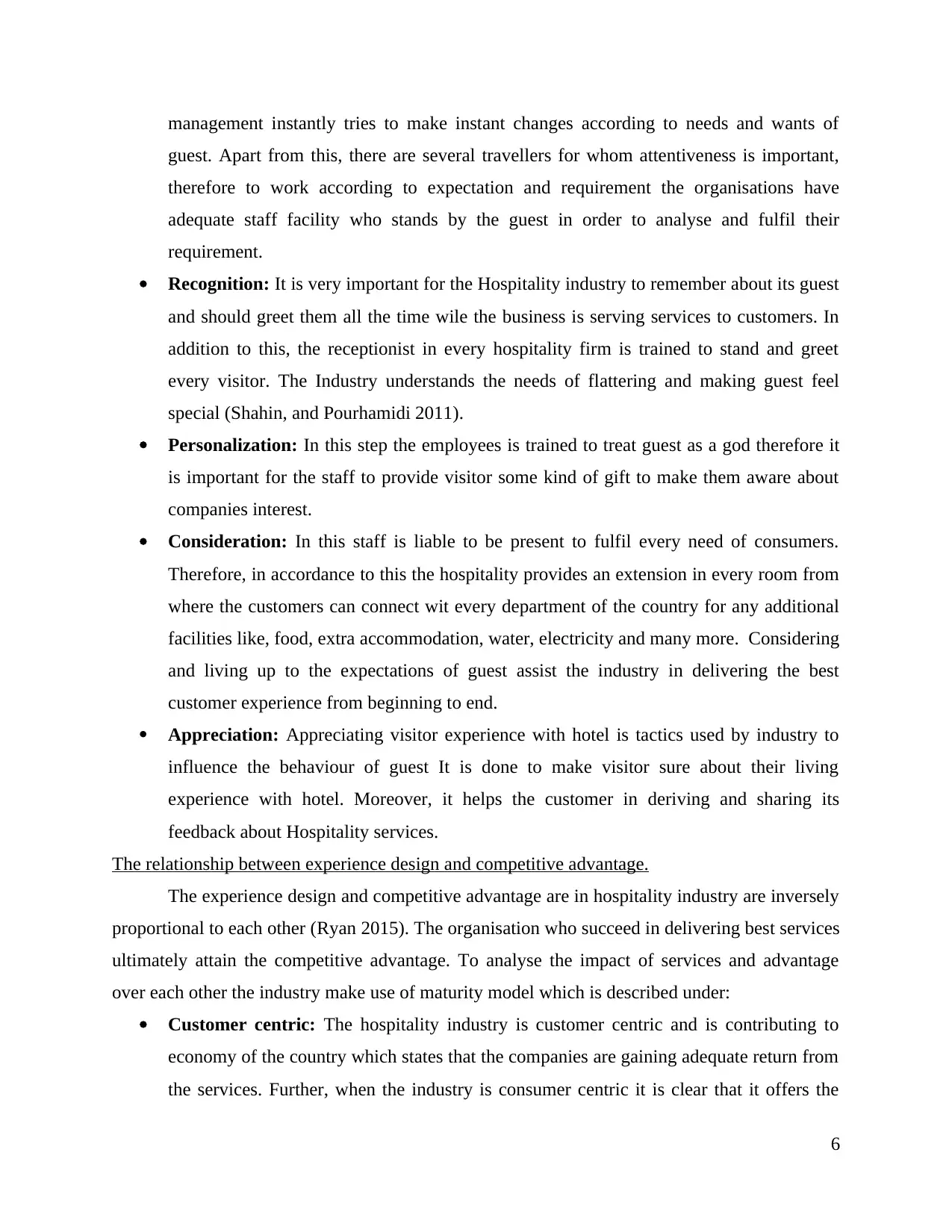
management instantly tries to make instant changes according to needs and wants of
guest. Apart from this, there are several travellers for whom attentiveness is important,
therefore to work according to expectation and requirement the organisations have
adequate staff facility who stands by the guest in order to analyse and fulfil their
requirement.
Recognition: It is very important for the Hospitality industry to remember about its guest
and should greet them all the time wile the business is serving services to customers. In
addition to this, the receptionist in every hospitality firm is trained to stand and greet
every visitor. The Industry understands the needs of flattering and making guest feel
special (Shahin, and Pourhamidi 2011).
Personalization: In this step the employees is trained to treat guest as a god therefore it
is important for the staff to provide visitor some kind of gift to make them aware about
companies interest.
Consideration: In this staff is liable to be present to fulfil every need of consumers.
Therefore, in accordance to this the hospitality provides an extension in every room from
where the customers can connect wit every department of the country for any additional
facilities like, food, extra accommodation, water, electricity and many more. Considering
and living up to the expectations of guest assist the industry in delivering the best
customer experience from beginning to end.
Appreciation: Appreciating visitor experience with hotel is tactics used by industry to
influence the behaviour of guest It is done to make visitor sure about their living
experience with hotel. Moreover, it helps the customer in deriving and sharing its
feedback about Hospitality services.
The relationship between experience design and competitive advantage.
The experience design and competitive advantage are in hospitality industry are inversely
proportional to each other (Ryan 2015). The organisation who succeed in delivering best services
ultimately attain the competitive advantage. To analyse the impact of services and advantage
over each other the industry make use of maturity model which is described under:
Customer centric: The hospitality industry is customer centric and is contributing to
economy of the country which states that the companies are gaining adequate return from
the services. Further, when the industry is consumer centric it is clear that it offers the
6
guest. Apart from this, there are several travellers for whom attentiveness is important,
therefore to work according to expectation and requirement the organisations have
adequate staff facility who stands by the guest in order to analyse and fulfil their
requirement.
Recognition: It is very important for the Hospitality industry to remember about its guest
and should greet them all the time wile the business is serving services to customers. In
addition to this, the receptionist in every hospitality firm is trained to stand and greet
every visitor. The Industry understands the needs of flattering and making guest feel
special (Shahin, and Pourhamidi 2011).
Personalization: In this step the employees is trained to treat guest as a god therefore it
is important for the staff to provide visitor some kind of gift to make them aware about
companies interest.
Consideration: In this staff is liable to be present to fulfil every need of consumers.
Therefore, in accordance to this the hospitality provides an extension in every room from
where the customers can connect wit every department of the country for any additional
facilities like, food, extra accommodation, water, electricity and many more. Considering
and living up to the expectations of guest assist the industry in delivering the best
customer experience from beginning to end.
Appreciation: Appreciating visitor experience with hotel is tactics used by industry to
influence the behaviour of guest It is done to make visitor sure about their living
experience with hotel. Moreover, it helps the customer in deriving and sharing its
feedback about Hospitality services.
The relationship between experience design and competitive advantage.
The experience design and competitive advantage are in hospitality industry are inversely
proportional to each other (Ryan 2015). The organisation who succeed in delivering best services
ultimately attain the competitive advantage. To analyse the impact of services and advantage
over each other the industry make use of maturity model which is described under:
Customer centric: The hospitality industry is customer centric and is contributing to
economy of the country which states that the companies are gaining adequate return from
the services. Further, when the industry is consumer centric it is clear that it offers the
6
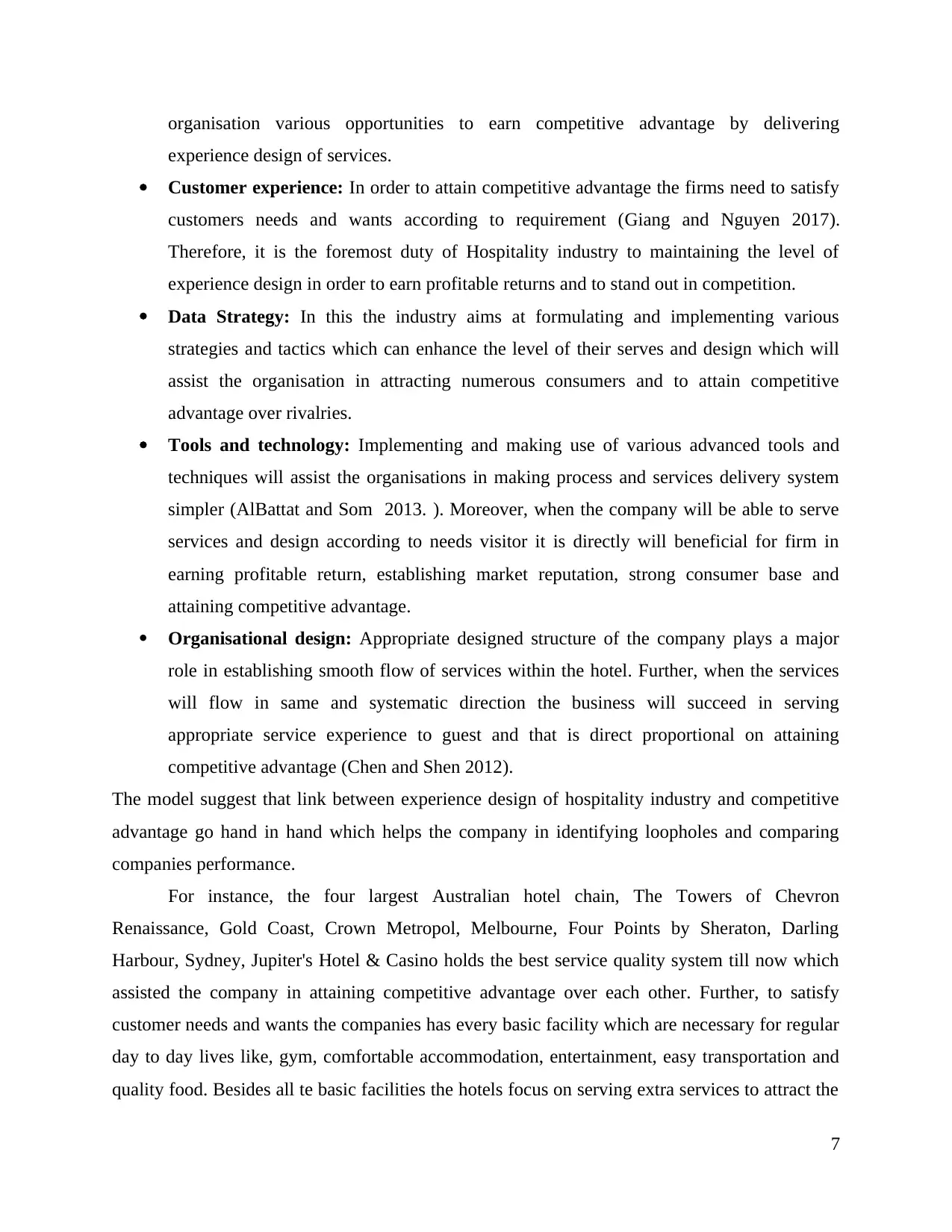
organisation various opportunities to earn competitive advantage by delivering
experience design of services.
Customer experience: In order to attain competitive advantage the firms need to satisfy
customers needs and wants according to requirement (Giang and Nguyen 2017).
Therefore, it is the foremost duty of Hospitality industry to maintaining the level of
experience design in order to earn profitable returns and to stand out in competition.
Data Strategy: In this the industry aims at formulating and implementing various
strategies and tactics which can enhance the level of their serves and design which will
assist the organisation in attracting numerous consumers and to attain competitive
advantage over rivalries.
Tools and technology: Implementing and making use of various advanced tools and
techniques will assist the organisations in making process and services delivery system
simpler (AlBattat and Som 2013. ). Moreover, when the company will be able to serve
services and design according to needs visitor it is directly will beneficial for firm in
earning profitable return, establishing market reputation, strong consumer base and
attaining competitive advantage.
Organisational design: Appropriate designed structure of the company plays a major
role in establishing smooth flow of services within the hotel. Further, when the services
will flow in same and systematic direction the business will succeed in serving
appropriate service experience to guest and that is direct proportional on attaining
competitive advantage (Chen and Shen 2012).
The model suggest that link between experience design of hospitality industry and competitive
advantage go hand in hand which helps the company in identifying loopholes and comparing
companies performance.
For instance, the four largest Australian hotel chain, The Towers of Chevron
Renaissance, Gold Coast, Crown Metropol, Melbourne, Four Points by Sheraton, Darling
Harbour, Sydney, Jupiter's Hotel & Casino holds the best service quality system till now which
assisted the company in attaining competitive advantage over each other. Further, to satisfy
customer needs and wants the companies has every basic facility which are necessary for regular
day to day lives like, gym, comfortable accommodation, entertainment, easy transportation and
quality food. Besides all te basic facilities the hotels focus on serving extra services to attract the
7
experience design of services.
Customer experience: In order to attain competitive advantage the firms need to satisfy
customers needs and wants according to requirement (Giang and Nguyen 2017).
Therefore, it is the foremost duty of Hospitality industry to maintaining the level of
experience design in order to earn profitable returns and to stand out in competition.
Data Strategy: In this the industry aims at formulating and implementing various
strategies and tactics which can enhance the level of their serves and design which will
assist the organisation in attracting numerous consumers and to attain competitive
advantage over rivalries.
Tools and technology: Implementing and making use of various advanced tools and
techniques will assist the organisations in making process and services delivery system
simpler (AlBattat and Som 2013. ). Moreover, when the company will be able to serve
services and design according to needs visitor it is directly will beneficial for firm in
earning profitable return, establishing market reputation, strong consumer base and
attaining competitive advantage.
Organisational design: Appropriate designed structure of the company plays a major
role in establishing smooth flow of services within the hotel. Further, when the services
will flow in same and systematic direction the business will succeed in serving
appropriate service experience to guest and that is direct proportional on attaining
competitive advantage (Chen and Shen 2012).
The model suggest that link between experience design of hospitality industry and competitive
advantage go hand in hand which helps the company in identifying loopholes and comparing
companies performance.
For instance, the four largest Australian hotel chain, The Towers of Chevron
Renaissance, Gold Coast, Crown Metropol, Melbourne, Four Points by Sheraton, Darling
Harbour, Sydney, Jupiter's Hotel & Casino holds the best service quality system till now which
assisted the company in attaining competitive advantage over each other. Further, to satisfy
customer needs and wants the companies has every basic facility which are necessary for regular
day to day lives like, gym, comfortable accommodation, entertainment, easy transportation and
quality food. Besides all te basic facilities the hotels focus on serving extra services to attract the
7
⊘ This is a preview!⊘
Do you want full access?
Subscribe today to unlock all pages.

Trusted by 1+ million students worldwide
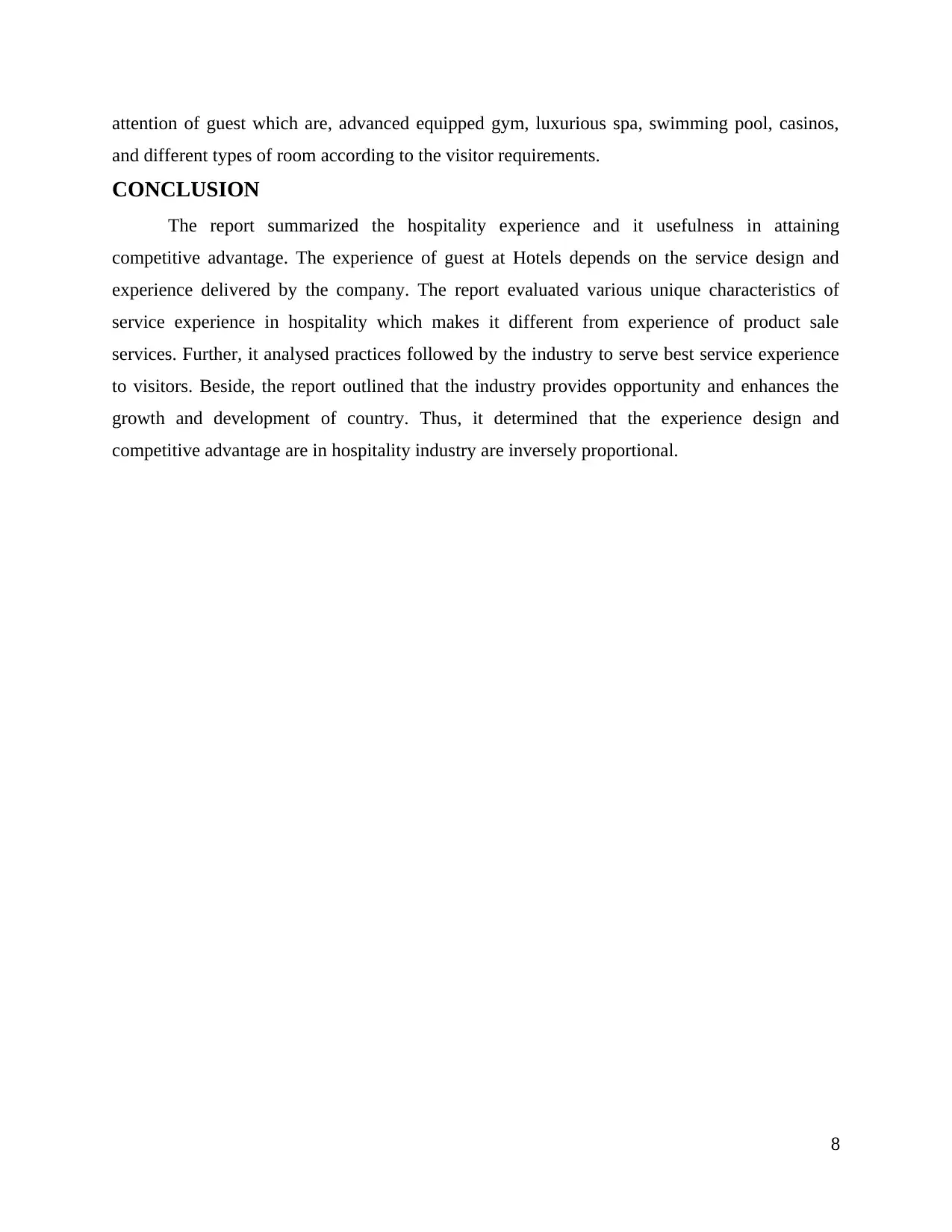
attention of guest which are, advanced equipped gym, luxurious spa, swimming pool, casinos,
and different types of room according to the visitor requirements.
CONCLUSION
The report summarized the hospitality experience and it usefulness in attaining
competitive advantage. The experience of guest at Hotels depends on the service design and
experience delivered by the company. The report evaluated various unique characteristics of
service experience in hospitality which makes it different from experience of product sale
services. Further, it analysed practices followed by the industry to serve best service experience
to visitors. Beside, the report outlined that the industry provides opportunity and enhances the
growth and development of country. Thus, it determined that the experience design and
competitive advantage are in hospitality industry are inversely proportional.
8
and different types of room according to the visitor requirements.
CONCLUSION
The report summarized the hospitality experience and it usefulness in attaining
competitive advantage. The experience of guest at Hotels depends on the service design and
experience delivered by the company. The report evaluated various unique characteristics of
service experience in hospitality which makes it different from experience of product sale
services. Further, it analysed practices followed by the industry to serve best service experience
to visitors. Beside, the report outlined that the industry provides opportunity and enhances the
growth and development of country. Thus, it determined that the experience design and
competitive advantage are in hospitality industry are inversely proportional.
8
Paraphrase This Document
Need a fresh take? Get an instant paraphrase of this document with our AI Paraphraser
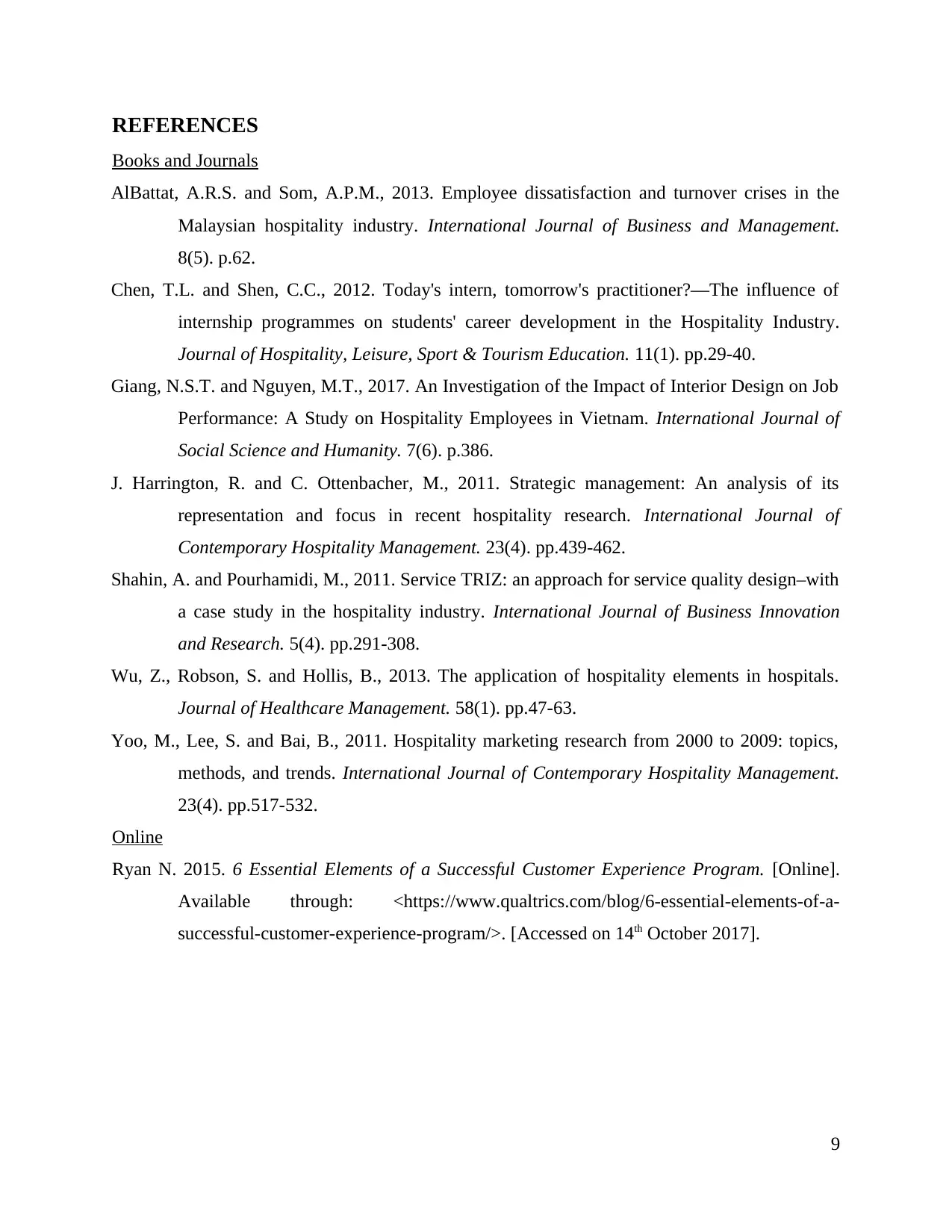
REFERENCES
Books and Journals
AlBattat, A.R.S. and Som, A.P.M., 2013. Employee dissatisfaction and turnover crises in the
Malaysian hospitality industry. International Journal of Business and Management.
8(5). p.62.
Chen, T.L. and Shen, C.C., 2012. Today's intern, tomorrow's practitioner?—The influence of
internship programmes on students' career development in the Hospitality Industry.
Journal of Hospitality, Leisure, Sport & Tourism Education. 11(1). pp.29-40.
Giang, N.S.T. and Nguyen, M.T., 2017. An Investigation of the Impact of Interior Design on Job
Performance: A Study on Hospitality Employees in Vietnam. International Journal of
Social Science and Humanity. 7(6). p.386.
J. Harrington, R. and C. Ottenbacher, M., 2011. Strategic management: An analysis of its
representation and focus in recent hospitality research. International Journal of
Contemporary Hospitality Management. 23(4). pp.439-462.
Shahin, A. and Pourhamidi, M., 2011. Service TRIZ: an approach for service quality design–with
a case study in the hospitality industry. International Journal of Business Innovation
and Research. 5(4). pp.291-308.
Wu, Z., Robson, S. and Hollis, B., 2013. The application of hospitality elements in hospitals.
Journal of Healthcare Management. 58(1). pp.47-63.
Yoo, M., Lee, S. and Bai, B., 2011. Hospitality marketing research from 2000 to 2009: topics,
methods, and trends. International Journal of Contemporary Hospitality Management.
23(4). pp.517-532.
Online
Ryan N. 2015. 6 Essential Elements of a Successful Customer Experience Program. [Online].
Available through: <https://www.qualtrics.com/blog/6-essential-elements-of-a-
successful-customer-experience-program/>. [Accessed on 14th October 2017].
9
Books and Journals
AlBattat, A.R.S. and Som, A.P.M., 2013. Employee dissatisfaction and turnover crises in the
Malaysian hospitality industry. International Journal of Business and Management.
8(5). p.62.
Chen, T.L. and Shen, C.C., 2012. Today's intern, tomorrow's practitioner?—The influence of
internship programmes on students' career development in the Hospitality Industry.
Journal of Hospitality, Leisure, Sport & Tourism Education. 11(1). pp.29-40.
Giang, N.S.T. and Nguyen, M.T., 2017. An Investigation of the Impact of Interior Design on Job
Performance: A Study on Hospitality Employees in Vietnam. International Journal of
Social Science and Humanity. 7(6). p.386.
J. Harrington, R. and C. Ottenbacher, M., 2011. Strategic management: An analysis of its
representation and focus in recent hospitality research. International Journal of
Contemporary Hospitality Management. 23(4). pp.439-462.
Shahin, A. and Pourhamidi, M., 2011. Service TRIZ: an approach for service quality design–with
a case study in the hospitality industry. International Journal of Business Innovation
and Research. 5(4). pp.291-308.
Wu, Z., Robson, S. and Hollis, B., 2013. The application of hospitality elements in hospitals.
Journal of Healthcare Management. 58(1). pp.47-63.
Yoo, M., Lee, S. and Bai, B., 2011. Hospitality marketing research from 2000 to 2009: topics,
methods, and trends. International Journal of Contemporary Hospitality Management.
23(4). pp.517-532.
Online
Ryan N. 2015. 6 Essential Elements of a Successful Customer Experience Program. [Online].
Available through: <https://www.qualtrics.com/blog/6-essential-elements-of-a-
successful-customer-experience-program/>. [Accessed on 14th October 2017].
9
1 out of 11
Related Documents
Your All-in-One AI-Powered Toolkit for Academic Success.
+13062052269
info@desklib.com
Available 24*7 on WhatsApp / Email
![[object Object]](/_next/static/media/star-bottom.7253800d.svg)
Unlock your academic potential
Copyright © 2020–2025 A2Z Services. All Rights Reserved. Developed and managed by ZUCOL.





